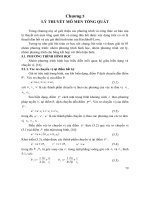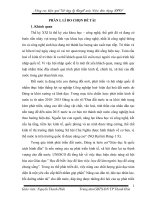Thuyet MO
Bạn đang xem bản rút gọn của tài liệu. Xem và tải ngay bản đầy đủ của tài liệu tại đây (305.25 KB, 12 trang )
Molecular orbital
Jump to: navigation, search
In chemistry, a molecular orbital (or MO) is a region in which an electron may be found
in a molecule.
[1]
Molecular orbitals are described by wave functions, mathematical
solutions to the Schrödinger wave equation for a molecule, which specify the spatial
distribution and energy of up to two electrons within it. They can be quantitatively
approximated using the Hartree-Fock or Self-Consistent Field method.
Overview
A molecular orbital (MO) specifies the spatial distribution and energy of one (or one pair
of) electron(s). Most commonly an MO is represented as a
linear combination of atomic orbitals (the LCAO-MO method), especially in qualitative or
very approximate usage. They are invaluable in providing a simple model of bonding in
molecules.
Most methods in computational chemistry today start by calculating the MOs of the
system. A molecular orbital describes the behavior of one electron in the electric field
generated by the nuclei and some average distribution of the other electrons. In the case of
two electrons occupying the same orbital, the Pauli principle demands that they have
opposite spin. Necessarily this is an approximation, and highly accurate descriptions of the
molecular electronic wave function do not have orbitals (see configuration interaction).
Qualitative discussion
For an imprecise, but qualitatively useful, discussion of the molecular structure, the
molecular orbitals can be obtained from the "Linear combination of atomic orbitals
molecular orbital method" ansatz. In this approach, the molecular orbitals are expressed as
linear combinations of atomic orbitals.
Molecular orbitals were first introduced by Friedrich Hund and Robert S. Mulliken in 1927
and 1928.
[2]
[3]
The linear combination of atomic orbitals approximation for molecular
orbitals was introduced in 1929 by Sir John Lennard-Jones.
[4]
. His ground-breaking paper
showed how to derive the electronic structure of the fluorine and oxygen molecules from
quantum principles. This qualitative approach to molecular orbital theory is part of the start
of modern quantum chemistry.
Some properties:
• The number of molecular orbitals is equal to the number the atomic orbitals
included in the linear expansion,
• If the molecule has some symmetry, the degenerate atomic orbitals (with the same
atomic energy) are grouped in linear combinations (called symmetry adapted
atomic orbitals (SO)) which belong to the representation of the symmetry group,
so the wave functions that describe the group are known as symmetry-adapted
linear combinations (SALC).
• The number of molecular orbitals belonging to one group representation is equal to
the number of symmetry adapted atomic orbitals belonging to this representation,
• Within a particular representation, the symmetry adapted atomic orbitals mix more
if their atomic energy level are closer.
[edit] Examples
[edit] H
2
H
2
1sσ* antibonding molecular orbital
As a simple example consider the hydrogen molecule, H
2
(see molecular orbital diagram),
with the two atoms labelled H' and H". The lowest-energy atomic orbitals, 1s' and 1s", do
not transform according to the symmetries of the molecule. However, the following
symmetry adapted atomic orbitals do:
1s' - 1s"
Antisymmetric combination: negated by reflection, unchanged by other
operations
1s' + 1s" Symmetric combination: unchanged by all symmetry operations
The symmetric combination (called a bonding orbital) is lower in energy than the basis
orbitals, and the antisymmetric combination (called an antibonding orbital) is higher.
Because the H
2
molecule has two electrons, they can both go in the bonding orbital, making
the system lower in energy (and hence more stable) than two free hydrogen atoms. This is
called a covalent bond. The bond order is equal to the number of bonding electrons minus
the number of antibonding electrons, divided by 2. In this example there are 2 electrons in
the bonding orbital and none in the antibonding orbital; the bond order is 1, and there is a
single bond between the two hydrogen atoms.
[edit] He
2
On the other hand, consider the hypothetical molecule of He
2
(see molecular orbital
diagram) with the atoms labelled He' and He". Again, the lowest-energy atomic orbitals, 1s'
and 1s", do not transform according to the symmetries of the molecule, while the following
symmetry adapted atomic orbitals do:
1s' - 1s"
Antisymmetric combination: negated by reflection, unchanged by other
operations
1s' + 1s" Symmetric combination: unchanged by all symmetry operations
Similar to the molecule H
2
, the symmetric combination (called a bonding orbital) is lower
in energy than the basis orbitals, and the antisymmetric combination (called an antibonding
orbital) is higher. However, in its neutral ground state, each Helium atom contains two
electrons in its 1s orbital, combining for a total of four electrons. Two electrons fill the
lower energy bonding orbital, while the remaining two fill the higher energy antibonding
orbital. Thus, the resulting electron density around the molecule does not support the
formation of a bond between the two atoms (called a sigma bond), and the molecule does
therefore not exist. Another way of looking at it is that there are two bonding electrons and
two antibonding electrons; therefore, the bond order is 0 and no bond exists.
[edit] Noble gases
Considering a hypothetical molecule of He
2
, since the basis set of atomic orbitals is the
same as in the case of H
2
, we find that both the bonding and antibonding orbitals are filled,
so there is no energy advantage to the pair. HeH would have a slight energy advantage, but
not as much as H
2
+ 2 He, so the molecule exists only a short while. In general, we find that
atoms such as He that have completely full energy shells rarely bond with other atoms.
Except for short-lived Van der Waals complexes, there are very few noble gas compounds
known.
[edit] Ionic bonds
Main article: Ionic bond
When the energy difference between the atomic orbitals of two atoms is quite large, one
atom's orbitals contribute almost entirely to the bonding orbitals, and the other's almost
entirely to the antibonding orbitals. Thus, the situation is effectively that some electrons
have been transferred from one atom to the other. This is called a (mostly) ionic bond.
[edit] MO diagrams
Main article: Molecular orbital diagram
For more complicated molecules, the wave mechanics approach loses utility in a qualitative
understanding of bonding (although is still necessary for a quantitative approach). The
qualitative approach of MO uses a molecular orbital diagram. In this type of diagram, the
molecular orbitals are represented by horizontal lines; the higher a line, the higher the
energy of the orbital, and degenerate orbitals are placed on the same level with a space
between them. Then, the electrons to be placed in the molecular orbitals are slotted in one
by one, keeping in mind the Pauli exclusion principle and Hund's rule of maximum
multiplicity (only 2 electrons, having opposite spins, per orbital; have as many unpaired
electrons on one energy level as possible before starting to pair them).
[edit] More quantitative approach
To obtain quantitative values for the molecular energy levels, one needs to have molecular
orbitals which are such that the configuration interaction (CI) expansion converges fast
towards the full CI limit. The most common method to obtain such functions is the Hartree-
Fock method which expresses the molecular orbitals as eigenfunctions of the Fock
operator. One usually solves this problem by expanding the molecular orbitals as linear
combinations of gaussian functions centered on the atomic nuclei (see linear combination
of atomic orbitals and basis set (chemistry)). The equation for the coefficients of these
linear combinations is a generalized eigenvalue equation known as the Roothaan equations
which are in fact a particular representation of the Hartree-Fock equation.
Simple accounts often suggest that experimental molecular orbital energies can be obtained
by the methods of ultra-violet photoelectron spectroscopy for valence orbitals and X-ray
photoelectron spectroscopy for core orbitals. This however is incorrect as these
experiments measure the ionization energy, the difference in energy between the molecule
and one of the ions resulting from the removal of one electron. Ionization energies are
linked approximately to orbital energies by Koopmans' theorem. While the agreement
between these two values can be close for some molecules, it can be very poor in other
cases.
MO diagram
From Wikipedia, the free encyclopedia
Jump to: navigation, search
A molecular orbital diagram or MO diagram for short is a qualitative descriptive tool
explaining chemical bonding in molecules in terms of molecular orbital theory in general
and the Linear combination of atomic orbitals molecular orbital method (LCAO method) in
particular
[1]
[2]
[3]
. This tool is very well suited for simple diatomic molecules such as
dihydrogen, dioxygen and carbon monoxide but becomes more complex when discussing
polynuclear molecules such as methane. It explains why some molecules exist and not
others, how strong bonds are, and what electronic transitions take place.
Contents
[hide]
• 1 Dihydrogen MO diagram
• 2 Dihelium MO diagram
• 3 Dilithium MO diagram
• 4 Diboron MO diagram
• 5 Dioxygen MO diagram
• 6 External links
• 7 See also
• 8 References
[edit] Dihydrogen MO diagram
The smallest molecule, hydrogen gas exists as dihydrogen (H-H) with a single covalent
bond between two hydrogen atoms. As each hydrogen atom has a single 1s atomic orbital
for its electron, the bond forms by overlap of these two atomic orbitals. In figure 1 the two
atomic orbitals are depicted on the left and on the right. The vertical axis always represents
the orbital energies. The atomic orbital energy correlates with electronegativity as a more
electronegative atom holds an electron more tightly thus lowering its energy. MO treatment
is only valid when the atomic orbitals have comparable energy; when they differ greatly the
mode of bonding becomes ionic. Each orbital is singly occupied with the up and down
arrows representing an electron.









